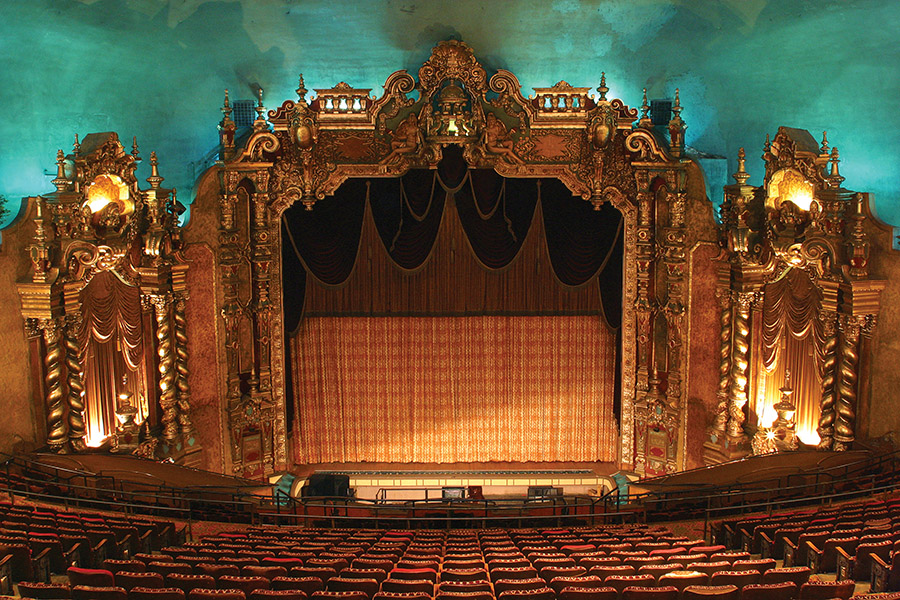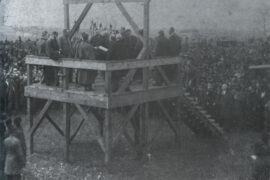Fundraising campaign gives the public a chance to purchase a piece of the Keith-Albee.
By Dawn Nolan
HQ 98 | SUMMER 2017
Next year, Huntington’s beloved Keith-Albee will turn 90. “The Keith-Albee is the centerpiece of our downtown and always has been,” says David Tyson, co-president of the Keith Albee Performing Arts Center (KAPAC) Foundation. “It’s the only remaining Thomas Lamb-designed atmospheric theatre in the world.”
“It’s in pretty good shape for a theatre of its age, and that’s a true testament to the Hyman family,” adds Robert “Bob” Plymale, KAPAC co-president.
Yet, as with any structure that old, ongoing preservation work must be done to keep the Keith-Albee not only an attractive sight and functioning performance and event venue, but also a National Historic Landmark.
“The main thing that everyone has to remember is that this is their theatre. We have a responsibility to restore it to the way it was,” says Liza Caldwell, who chairs KAPAC’s Building Committee.
Since KAPAC took over the Keith-Albee’s operations in 2006, various renovation projects — all funded through public funding and private donations — have been completed, some of which include: returning the lobby and theatre to its original configuration, repairing the marquee sign, replacing the roof, upgrading the HVAC system, adding a handicap-accessible restroom on the orchestra level and installing a new pulley apparatus for stage productions.
“We first wanted to get the theatre back to its original size,” Plymale explains. “It was a major effort to knock down walls in the lobby in preparation for the We Are Marshall premiere.”
“Though many people wanted to see cosmetic issues taken care of immediately, we decided it was best to focus on the outside and the building’s infrastructure,” Tyson adds.
KAPAC’s latest endeavor is the “Take a Seat Under the Stars” campaign, which launched in December. Marshall Artists Series graduate assistant Shaleena Ross came up with the name, and local advertising agency Bulldog Creative is leading promotional efforts.

“The idea is to restore the seats, as close as possible, to the original ones,” Tyson says. “If you look at the balcony seats, they are similar in color and design to what the new seats will be. The new seats will be beautiful and comfortable, not to mention compliant to National Register standards.”
Before the seats can be replaced, however, all of the fabric must be bought.
“We have to purchase the material all at once because we want it to be done in the same run to ensure consistency,” Plymale explains. “That is the initial step and the initial expense.”
To cover these and associated costs, KAPAC is offering interested donors the chance to name a newly refurbished seat in any of three levels by purchasing a sponsorship. A “Maestro” sponsorship is $1,500 and consists of seats located in rows B through O on the orchestra level and the loge boxes. “Director” sponsorships are $1,200 and cover the remaining orchestra seats. Finally, “Conductor” sponsorships are $1,000 and include all regular balcony seats. A plaque will hang in the lobby honoring donors that contribute $1,000 or more to the campaign.
“Donations are coming along,” Tyson says. “People want to see that we’re making progress.”
A special “We Are Marshall” Memorial Designation — with name-plates honoring the 75 players, coaches and community members that were killed in the 1970 plane crash — will be located in the balcony. An anonymous donor gave the initial $20,000 back in December for the section, which features already allocated seats for Gene Morehouse, “The Voice of the Herd,” and offensive lineman Bob Patterson, of Louisburg, North Carolina.
“At this point, 20 of the 75 seats have been purchased,” Plymale says.
In addition to individuals, corporate donors, such as Brickstreet Insurance, Cabell Huntington Hospital and St. Mary’s Medical Center, have also contributed to the $2.6 million project.
“We’re at about the $300,000 mark,” says Plymale. “We’ve had groups coming to us wanting to do two- or three-year pledges. We’ll accommodate people in just about every way that we can facilitate.”
Once funding is raised, KAPAC estimates that it will take about two years to fully replace the 2,000-plus seats.
“We’d like it to happen faster than that, but the replacement can’t happen all at once,” Plymale explains. “We have to do it in stages so that we don’t interfere with performances and other activities. We will not cancel events.”
To start the restoration process, Caldwell consulted with Andrew Myers and A.J. Stovitz of Andrew Myers Interior Design, to determine the patterns and colors used on the seats as well as identifying manufacturers. Darren Diamond, of Diamond Furniture Restoration in Russell, Kentucky, is handling the production of the new seats.

“A year before we had done a massive clean of the basement, and sorted the seats out into parts,” Caldwell recalls. “We found one in the corner that was completely broken up, and Darren took it back to his shop and stripped it down to find out what it looked like originally.”
Once Diamond works his magic, each new seat will be installed back in its exact original position so as not to interfere with the theatre’s cooling system.
“This is going to be a difficult process,” Caldwell says. “We have to time the removal of the chairs correctly. Each chair will be handled individually. Darren will take a few dozen at a time, and those will be replaced with temporary chairs until the new ones are ready.”
One seat, donated to KAPAC by the late Mike Perry, has already been fully restored. Housed in the lobby of the Keith, it is being used as a model of the work to come.
“The upholstery on the new seats will be fire retardant and stain resistant,” Caldwell says. “It will look identical, but it will last longer and hold up better. You really won’t be able to tell the difference from the original.”
“When we finish this threatre’s restoration, it’s my vision that, as soon as you step under the marquee, you’ll be transported back to when the theatre was originally open, and inside it’ll be like it was in 1929.”





